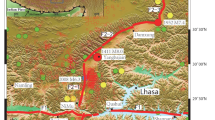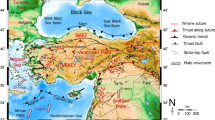Abstract
The Himalayan Main Frontal Thrust is the most active fault in the Himalayan subduction zone, with a high degree of locking and a large thrust rate. Gaps on the Himalayan Main Frontal Thrust have been free of strong earthquakes for hundreds of years and the surrounding areas are densely populated, so it is significant to study the evolution law and the current status of stress along the Himalayan Main Frontal Thrust. Based on a lithospheric viscoelastic layered medium model, we analyzed the interseismic stress accumulation along the Himalayan Main Frontal Thrust and the coseismic and postseismic stress disturbance on the fault surface caused by nine Mw ≥ 7.5 earthquakes since 1803. The results showed that the stress disturbance along the Himalayan Main Frontal Thrust caused by historical earthquakes have promoted most of the subsequent earthquakes, but the coseismic and postseismic stress changes caused by the historical earthquakes on the faulty surface of subsequent earthquakes are not significant, because of the long distance between strong earthquakes. Interseismic stress enhanced the stress level of the majority of fault planes in the study area and played a dominant role in the stress evolution and strong earthquake preparation along the Himalayan Main Frontal Thrust. The recurrence interval of Mw 7.5–7.9 earthquakes on the Himalayan Main Frontal Thrust is 70–250 years and the recurrence interval of Mw > 8 earthquakes which rupture the whole seismogenic layer may be longer than 500 years. This agrees with historical seismic records. The elapsed time of strong earthquakes in the four seismic gaps is between 460 and 915 years and the possibilities of Mw 8 earthquakes in the future 10 years always exist, including a probability of higher than 50% in three seismic gaps. The peak of cumulative Coulomb stress in the seismic gaps is more than 1 MPa, and the seismic hazard on the Himalayan Main Frontal Thrust needs further attention.








Similar content being viewed by others
References
Ader, T., Avouac, J. P., Zeng, J. L., et al. (2012). Convergence rate across the Nepal Himalaya and interseismic coupling on the Main Himalayan Thrust: implications for seismic hazard. Journal of Geophysical Research, 117, B04403. doi:10.1029/2011JB009071.
Apel, E.V., Burgmann, R., Banerjee, P. (2010). Indian plate motion, deformation, and plate boundary interactions. Geophysical Journal International (in press).
Avouac, J. P. (2015). From geodetic imaging of seismic and aseismic fault slip to dynamic modeling of the seismic cycle. Annual Review of Earth and Planetary Sciences, 43(1), 233–271. doi:10.1146/annurev-earth-060614-105302.
Avouac, J. P., Meng, L., Wei, S., et al. (2015). Lower edge of locked Main Himalayan Thrust unzipped by the 2015 Gorkha earthquake. Nature Geoscience. doi:10.1038/NGEO2518.
Bilham, R., & England, P. (2001). Plateau ‘pop-up’ in the great 1897 Assam earthquake. Nature, 410(6830), 806–809.
Bollinger, L., Avouac, J. P., Cattin, R., et al. (2004). Stress buildup in the Himalaya. Journal of Geophysical Research, 109, B11405. doi:10.1029/2003JB002911.
Cattin, R., & Avouac, J. P. (2000). Modeling mountain building and the seismic cycle in the Himalaya of Nepal. Journal of Geophysical Research, 105(B6), 13389–13407. doi:10.1029/2000JB900032.
Chen, W. P., & Molnar, P. (1977). Seismic moments of major earthquakes and the average rate of slip in central Asia. Journal of Geophysical Research, 82(20), 2945–2969.
Ellsworth, W. L. (1999). A physically based earthquake recurrence model for estimation of long-term earthquake probabilities. In Open-file Report: 99-552. Reston, VA: U.S. Geological Survey.
Gualandi, A., Avouac, J.P., Galetzka, J., et al. (2016). Pre- and post-seismic deformation related to the 2015, Mw7.8 Gorkha earthquake, Nepal. Tectonophysics (in press).
Kumar, S., Wesnousky, S. G., Jayangondaperumal, R., et al. (2010). Paleoseismological evidence of surface faulting along the northeastern Himalayan front, India: Timing, size, and spatial extent of great earthquakes. Journal of Geophysical Research, 115, B12422. doi:10.1029/2009JB006789.
Kumar, S., Wesnousky, S. G., Rockwell, T. K., et al. (2001). Earthquake recurrence and rupture dynamics of Himalayan Frontal Thrust, India. Science, 294(5550), 2328–2331.
Kumar, S., Wesnousky, S. G., Rockwell, T. K., et al. (2006). Paleoseismic evidence of great surface-rupture earthquakes along the Indian Himalaya. Journal of Geophysical Research, 111, B03304. doi:10.1029/2004JB003309.
Li, B. K., Diao, G. L., Xu, X. W., et al. (2015). Redetermination of the source parameters of the Zayü, Tibet M8.6 earthquake sequence in 1950. Chinese Journal Geophysics, 58(11), 4254–4265. doi:10.6038/cjg20151130.
Liu, C., Zheng, Y., Wang, R., et al. (2016). Rupture processes of the 2015 Mw 7.9 Gorkha earthquake and its Mw 7.3 aftershock and their implications on the seismic risk. Tectonophysics, 682, 264–277.
Matu’ura, M., Jackson, D. D., & Cheng, A. (1986). Dislocation model for aseismic crustal deformation at Hollister. California. Journal of Geophysical Research, 91(B12), 12661–12674.
Molnar, P., & Deng, Q. D. (1984). Faulting associated with large earthquake and the average rate of deformation in central and eastern Asia. Journal of Geophysical Research, 89, 6203–6227.
Parsons, T., Stein, R. S., Simpson, R. W., et al. (1999). Stress sensitivity of fault seismicity: A comparison between limited-offset oblique and major strike-slip faults. Journal of Geophysical Research, 104, 20183–20202.
Parsons, T., Yeats, R. S., Yagi, Y., et al. (2006). Static stress change from the 8 October, 2005 M = 7.6 Kashmir earthquake. Geophysical Research Letters, 33, L06304. doi:10.1029/2005GL025429.
Petersen, M. D., & Frankel, A. D., et al. (2008). Documentation for the 2008 Update of the United States National Seismic Hazard Maps. In US Geological Survey Open-File Report (no. 2008–1128, p. 61).
Rajendran, C. P., & Rajendran, K. (2005). The status of central seismic gap: a perspective based on the spatial and temporal aspects of the large Himalayan earthquakes. Tectonophysics, 395(1–2):19–39.
Rajendran, K., & Rajendran, C. (2011). Revisiting the earthquake sources in the Himalaya: Perspectives on past seismicity. Tectonophysics, 504, 75–88.
Rajendran, C. P., Rajendran, K., Duarah, B. P., et al. (2004). Interpreting the style of faulting and paleoseismicity associated with the 1897 Shillong, northeast India, earthquake: Implications for regional tectonism. Tectonics. doi:10.1029/2003TC001605.
Sapkota, S. N., Bollinger, L., Klinger, Y., et al. (2013). Primary surface ruptures of the great Himalayan earthquakes in 1934 and 1255. Nature Geoscience, 6, 71–76.
Scholz, C. H. (1990). The mechanics of earthquakes and faulting (p. 439). New York: Cambridge University Press.
Shan, B., Xiong, X., Wang, R. J., et al. (2013). Coulomb stress evolution along Xianshuihe-Xiaojiang Fault System since 1713 and its interaction with Wenchuan earthquake. Earth and Planetary Science Letters, 377, 199–210.
Stein, R. S. (1999). The role of stress transfer in earthquake occurrence. Nature, 402, 605–609.
Stein, R. S. (2003). Earthquake conversations. Scientific American, 288, 72–79.
Stein, R. S., Barka, A. A., & Dieterich, J. H. (1997). Progressive failure on the North Anatolian fault since 1939 by earthquake stress triggering. Geophysical Journal International, 128, 594–604.
Stevens, V. L., & Avouac, J. P. (2015). Interseismic coupling on the main Himalayan thrust. Geophysical Research Letters, 42, 5828–5837. doi:10.1002/2015GL064845.
Szeliga, W., Hough, S., Martin, S., et al. (2010). Intensity, magnitude, location, and attenuation in India for felt earthquakes since 1762. Bulletin of the Seismological Society of America, 100(2), 570–584.
Teng, J. W., Yuan, X. M., Zhang, Y. Q., et al. (2012). The stratificational velocity structure of crust and covering strata of upper mantle and the orbit of deep interaquifer substance locus of movement for Tibetan Plateau. Acta PetrologicaSinica, 28(12), 4077–4100.
Wan, Y. G., Shen, Z. K., Sheng, S. Z., et al. (2009). The influence of 2008 Wenchuan earthquake on surrounding faults. ActaSeismologicaSinica, 31(2), 128–139.
Wang, H., Liu, M., Cao, J., et al. (2011). Slip rates and seismic moment deficits on major active faults in mainland China. Journal of Geophysical Research, 116, B02405. doi:10.1029/2010JB007821.
Wang, R. J., Lorenzo-Martin, F., & Roth, F. (2006). PSGRN/PSCMP—a new code for calculating co- and post-seismic deformation, geoid and gravity changes based on the viscoelastic-gravitational dislocation theory. Computers and Geosciences, 32(4), 527–541.
Ward, S. N. (1994). A multidisciplinary approach to seismic hazard in southern California. Bulletin of the Seismological Society of America, 84, 1293–1309.
Wells, D. L., & Coppersmith, K. J. (1994). New empirical relationships among magnitude, rupture length, rupture width, rupture area, and surface displacement. Bulletin of the Seismological Society of America, 84, 974–1002.
Wessel, P., & Smith, W. H. F. (1995). New version of the Generic Mapping Tools released. Eos Trans AGU, 76, 329.
Xiong, X., Shan, B., Zheng, Y., et al. (2010). Stress transfer and its implication for earthquake hazard on the Kunlun Fault, Tibet. Tectonophysics, 482, 216–225.
Xiong, W., Tan, K., Liu, G., et al. (2015). Coseismic and postseismic Coulomb stress changes on surrounding major faults caused by the 2015 Nepal Mw7.9 earthquake. Chinese Journal Geophysics, 58(11), 4305–4316. doi:10.6038/cjg20151135.
Xiong, W., Tan, K., Yu, P. F., et al. (2016). Triggering of Mw5.9 Kangding earthquake by Coulomb stress evolution along Xianshuihe fault zone since 1955. Journal of Geodesy and Geodynamics, 36(2), 95–100.
Xu, J., Shao, Z. G., Ma, H. S., et al. (2013). Evolution of Coulomb stress and stress interaction among strong earthquakes along the Xianshuihe fault zone. Chinese Journal Geophysics, 56(4), 1146–1158. doi:10.6038/cjg20130410.
Xu, B., & Xu, C. J. (2015). Numerical simulation of influences of the earth medium’s lateral heterogeneity on co- and post-seismic deformation. Geodesy and Geodynamics, 6(1), 46–54. doi:10.1016/j.geog.2014.11.001.
Zhang, X. L., & Xie, F. R. (2009). Middle and long term seismic risk evaluation of southern Sichuan Yunnan region based on GPS data and Real-time probabilistic model. Journal of Geodesy and Geodynamics, 29(3), 38–41.
Zhao, W. J., Nelson, K. D., Che, J. K., et al. (1996). Deep seismic reflection in Himalaya region reveals the complexity of the crust and upper mantle structure. Chinese Journal Geophysics, 39(05), 615–628.
Zielke, O., & Arrowsmith, J. R. (2008). Depth variation of coseismic stress drop explains bimodal earthquake magnitude-frequency distribution. Geophysical Research Letters, 35, L24301.
Acknowledgements
We would like to thank Dr. Shan Bin from the Institute of Geodesy and Geophysics, Chinese Academy of Sciences for useful guidance on PSGRN/PSCMP software. We also feel grateful for Dr. Wang Jianjun from Wuhan University who gave us tremendous support in the calculations of interseismic stress. USGS provided the slip models of the 2005 Kashmir earthquake and the 2015 Nepal earthquake. Some figures were finished with Generic Mapping Tools (GMT) (Wessel and Smith 1995).
Author information
Authors and Affiliations
Corresponding author
Rights and permissions
About this article
Cite this article
Xiong, W., Tan, K., Qiao, X. et al. Coseismic, Postseismic and Interseismic Coulomb Stress Evolution Along the Himalayan Main Frontal Thrust Since 1803. Pure Appl. Geophys. 174, 1889–1905 (2017). https://doi.org/10.1007/s00024-017-1525-y
Received:
Revised:
Accepted:
Published:
Issue Date:
DOI: https://doi.org/10.1007/s00024-017-1525-y




